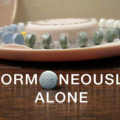In the early days of hormonal birth control, many physicians and politicians seemed extraordinarily indifferent to the side effects linked to the magic little pill, and world-renowned neurologist, Dr. David Clark could not hide his dismay. He lamented incredulously that it was as if The Pill had been granted some sort of “diplomatic immunity.”
In those days, when you referred to “The Pill,” you meant Enovid. It represented the only formulation – the only brand of hormonal birth control available. Yet, despite the limited exposure, specialists from many fields had already begun to sound alarm bells. They witnessed healthy, young women suddenly experiencing unusual outcomes, such as depression, lupus, and strokes. Unfortunately, those outcomes are not so unusual or uncommon today.
Now, a variety of methods deliver the potent drugs: patches, implants, injections, and even the IUD. We are nearly a quarter of a century into the fourth generation of progestins, while the estrogenic component of combination birth control has never changed. It is still the same ethinyl estradiol first tested by Nazi scientists on concentration camp prisoners as a means of chemical sterilization.
You would think that, with all the current options for birth control, if one method or one formulation stood out as particularly egregious, the diplomatic immunity for that specific method might be waived. I wrote previously about how the Depo injection still seems to enjoy protected status despite having some pretty serious flaws above and beyond other forms of birth control.
But surely the Food and Drug Administration (FDA) would respond differently if a new version of the same old combo pill presented more worrisome problems, right?
Checkered Record
Yasmin hit the market in 2001, and Yaz followed in 2006. Both featured a new synthetic steroid, a fourth generation progestin called drospirenone. Bayer tagged the new formulations with the slogan “Beyond birth control” because they claimed that, beyond pregnancy prevention, this new generation provided a solution for those suffering from acne and/or premenstrual dysphoric disorder (PMDD).
However, controversy began to enshroud the new drugs before Yaz even came to market. In 2003, the FDA notified the drug’s makers that their advertisements for Yasmin were misleading because their claim that it was more effective than other brands was unsubstantiated. Perhaps even worse, these ads failed to warn that the new formulation could elevate a user’s potassium to dangerous levels.
Shortly after the release of Yaz, the FDA began sending similar notifications. First came the same warning about exaggerated claims of efficacy. Then, they took issue with Yaz’s marketing that implied it treated PMDD and acne.
After discovering internal emails from Bayer executives discussing how they could get TV talkshow doctors to promote these “off label benefits,” it appeared that the FDA was finished playing games. They issued a recall of Yaz and Yasmin – well, sort of.
I Don’t Recall the Recall?
It was the most confusing recall ever. In the aftermath, even CBS news ran a story with the headline, “Did You Know the FDA Recalled Bayer’s Yaz Contraceptive? Neither Did Anyone Else.”
Something much more sinister than marketing misinformation and misleading semantics triggered the recall. Instead, the recall process was triggered because clinical trial data submitted to the FDA during the approval process had been tweaked to downplay the drug’s elevated risk of blood clots. Bayer took their data and averaged certain measurements to get the numbers they needed.
By 2009, blood clot lawsuits had begun to pile up. The French drug safety agency, ANSM would ultimately release findings that the new pills were responsible for twice as many deaths as previous generations of hormonal birth control. Other studies found that these drugs could be as much as three times more likely to cause blood clots than the already elevated risk of other birth control brands. By 2016, Bayer would pay out over $2 billion to settle more than 10,000 blood clot related lawsuits.
The FDA rarely takes action against any form of birth control, but they finally moved forward with the recall. The only problem was they buried it in the “Enforcement Report” section of their website instead of where recalls are normally posted. Even more confusing was the recall itself. Despite having raised concerns about dubious practices during the approval process, the recall seemed to focus on quality control issues at a particular factory in Germany. Ultimately, the recall only targeted approximately 33,000 boxes of Yaz and 122,000 boxes of the generic version, Ocella.
The Choice of a New Generation
Recall or not, it did not take long for the new birth control formulation to become one of Bayer’s top performers. The various brands associated with the new progestin brought in over $1.5 billion in sales in 2010, and the company’s profits increased by double digits.
All the while, the FDA compounded the confusion by continuing their investigation into the increased incidence of blood clots and mortality associated with drospirenone. By 2011, the scrutiny intensified as new studies showed that women on this combination were 74% more likely to suffer blood clots than other forms.
The insanity of the the mixed messages became equally intense. As the FDA’s advisory committee on drospirenone moved toward a plan of action, the agency suddenly disqualified Dr. Sidney Wolfe, the respected Director of Public Citizen, from the committee because of his “intellectual conflict of interest.” In other words, he had already expressed disapproval for this drug based on its poor safety record.
It would be hard to exaggerate the absurdity of this move. Our first thought might be to equate this to a juror being dismissed for coming into a trial with a biased prejudice against the defendant, but pharmaceuticals are NOT innocent until proven guilty! In fact, the burden of proof for both safety and efficacy is supposed to fall on the drug companies from the outset.
The FDA should never remove a qualified doctor from a committee for having pre-conceived, scientifically sound opinions about the drug in question.
A Toothless Penance
When the dust settled, the FDA ruled that Bayer needed to change the verbiage in the clunky patient information pamphlet that nobody reads anyway. But hey, at least it’s in there, so when more families look to sue Bayer for the loss of their daughter, Bayer can claim they were warned. It’s right there in black and white.
The temptation exists to think this entire situation perfectly portrays the ineptitude of a large governmental bureaucracy – incompetence run amok. Maybe they got sidetracked by the QC issues at the plant in Germany, but they hung with it and eventually forced Bayer to publish information about the elevated risks. Could we have really expected anything more from the jack-wagons at the FDA? I think we could have (and should have).
While it isn’t exactly a heroic example of consumer advocacy, the FDA did demonstrate a little more chutzpah when it came to another drug around the same time.
An Alternative NSAID
In 1999, Merck released a new drug to treat osteoarthritis. Primed to compete against Naproxen, a popular NSAID commonly known by the brand name, Aleve, Merck believed their new product, Vioxx, held a distinct advantage because they were convinced that it would cause less gastrointestinal issues than Aleve.
Eager to accentuate this key differentiator, they launched a massive study of 8,000 patients in January that same year. The Vioxx gastrointestinal outcomes research (VIGOR) study kicked off with points of comparison focused on gastric perforations, ulcers, and bleeds.
Things looked promising when the VIGOR data and safety monitoring panel (DSMP) made their first report to the FDA in October. Soon, they would publish the encouraging results in the New England Journal of Medicine (NEJM). Vioxx patients did indeed exhibit fewer ulcers and less gastrointestinal bleeding, but upon closer inspection, all those green pastures would be revealed to be astroturf.
The following month the DSMP admitted that nearly twice as many Vioxx patients in the study died from cardiovascular events than Naproxen patients, but they contended that the numbers were still low and voted to continue the trial. Without any evidence to back it up, the DSMP suggested that, rather than Vioxx contributing to cardiac issues, perhaps Naproxen provided a protective effect similar to aspirin that brought their numbers down.
Follow the Money
Much like Bayer with Yaz, it was later discovered that Merck took a little creative license with the numbers they presented to the FDA. The researchers took the highly unusual step of recording gastrointestinal events after they stopped recording cardiovascular events. By moving the goalpost for one and not the other, they were able to generate numbers that were much more favorable to Vioxx than what was reality.
Slowly, details of the unsettling truth behind Vioxx came to light. However, since we are talking about medicine and government agencies, we could just as accurately say that they came to light rather quickly.
In early 2000, Michael Weinblatt, the Chairman of the Vioxx DSMP filled out a disclosure form, where he admitted to owning $70,000 in Merck stock. Later that same month, he signed a lucrative new consulting contract with them.
Over the next year, news of at least three previously unreported heart attacks from among the Vioxx users in the study came to light – as did their clunky attempts to cover them up.
In February 2001, the FDA committed to transparency after holding an advisory board meeting related to the Vioxx trials. They sent a warning letter to Merck about their misrepresentation of the drug, and their attempts to downplay its higher risk of causing a stroke.
The agency subsequently published the entire database from the VIGOR study on their website. This allowed researchers outside Merck’s sphere of influence to perform a meta-analysis of the data, which ultimately knocked the wind out of the hypothesis regarding Naproxen’s protective affect on the heart.
Unlike their approach with Yaz and Bayer, the FDA’s charges against Merck and Vioxx were direct, clear, and well publicized. Their release of the entire VIGOR database left the company vulnerable.
As more evidence began to mount, Merck’s researchers wiped the egg off their faces and published a correction in NEJM. By September 2004, after continued intense pressure from the FDA, Merck decided to withdraw Vioxx from the market.
As the final bit of dust settled four years later, Merck settled thousands of heart attack and death lawsuits for $4.85 billion.
Corporate Conscience?
Ultimately, the downfall of Vioxx precipitated from the fact that there was already a safer drug on the market that met the same need. If Naproxen did not exist, it is entirely possible that the FDA would have determined that Vioxx’s benefits outweighed the risks and allowed it to remain on the shelves.
So, what about Yaz and Yasmin, for which there are numerous safer alternatives?
After the clunky recall and the required changes in patient information literature, the FDA acted as if it had done its job. When it came to Vioxx, it was ultimately Merck that decided to pull the product from the shelves after coercion from the FDA. Is it possible that Bayer would demonstrate a similar level of corporate conscience?
Believe it or not, this is where the story gets truly interesting, and it flew below my radar for years, until a young woman reached out to me to share her story. For the sake of telling it here, I will refer to her as Sara.
Sara’s Story
As the daughter of two physicians, Sara grew up feeling like the ultimate guinea pig. Since birth, with every symptom or vaguest sign of a symptom, one of her parents always seemed to have a sample drug from the office to try.
As she grew into the age of reason, she resented the perpetual overmedication. While she did not become anti-medicine, she did avoid running to pharmaceuticals with every sniff, cough, and tummy ache. She also vowed to be much more diligent about the chemicals she put in her body. She researched side effects for herself anytime a doctor proposed a new prescription.
Oddly, the same attention to detail did not apply when it was time to start birth control. Like so many women, in her mind, it was almost like hormonal birth control was not a drug. Her doctor prescribed Yaz, and she took it for a while with minimal side effects.
After a couple of years, Sara happened upon information about the questionable recall and concerns about the elevated risk of blood clots. She scheduled an appointment with her ObGyn and told him about her trepidation with continuing on Yaz. He listened empathetically and said he had some good news. He assured her that after so many questions had been raised, Bayer came out with a new, safer formula, called Beyaz.
Elated, Sara started the new prescription. Again, it took a couple of years for her natural pharmaceutical skepticism to activate, but it finally did. It did not take too much digging for her to discover that Beyaz was actually the exact same synthetic steroids at the exact same dosage as Yaz. The only difference – Bayer added a touch of folate.
Sara was outraged.
Why Beyaz?
Bayer claimed the inclusion of folate within the hormonal birth control would help reduce the risk of neural tube defects in case of any pregnancies that might happen while taking the drug.
Even NPR was confused by this “creative” twist on birth control, noting,
Like other modern birth control pills, Beyaz is 99 percent effective. But now the company can tell women their babies are less likely to have certain kinds of serious birth defects, if the pill fails to work for them.
Indeed, this must have presented a nearly impossible quandary for the marketing department. How do pitch a drug that offers benefits to the baby that it is supposed to prevent?
Everything about this enigmatic new formulation inspires questions beginning with why it was even necessary. There is a feasible explanation.
Bayer introduced Beyaz in late 2010 during the height of the fallout over Yaz’s elevated risks. One would have to be truly special to not at least entertain the notion that Beyaz was a strategic response to the bad news cycle.
Sold as Safer
It would be conjecture for me to suggest that Bayer trained their sales reps to tell doctors that the new drug resolved any problems swirling around Yaz. What isn’t conjecture though is that many doctors have been telling women who raise concerns about Yaz that Beyaz is Bayer’s safer alternative.
Sara reached out to me because she had joined several birth control groups on Facebook and found many other women who had a similar experience. They went to their doctor expressing concerns about Yaz and were prescribed Beyaz with the narrative that Bayer had created it as a safer alternative.
It’s possible that when you compare and contrast Vioxx and Yaz it reveals a difference in the two companies. After all, one company pulled their drug from the market, while the other, not only didn’t remove their drug from the market, but doubled-down with a devious new twist on their killer drug.
I think it has more to do with the difference between the two drugs being a pain reliever versus hormonal birth control. Both drugs gained FDA approval based on dubious data. In safety studies, each drug performed poorly against competing drugs that were already on the market. And the companies making both drugs paid billions of dollars to settle outstanding lawsuits. In the end, the pain reliever was removed from shelves, while the birth control formulation and all its sister products remain on the market all these years later.
For me, it represents one more example in a long line of curious situations over the past 60 years that seem to affirm that birth control has, in fact, been granted diplomatic immunity – consequences be damned.
We Need Your Help
More people than ever are reading Hormones Matter, a testament to the need for independent voices in health and medicine. We are not funded and accept limited advertising. Unlike many health sites, we don’t force you to purchase a subscription. We believe health information should be open to all. If you read Hormones Matter, like it, please help support it. Contribute now.
Yes, I would like to support Hormones Matter.
Image by Fathromi Ramdlon from Pixabay.


































